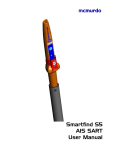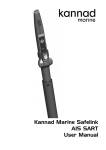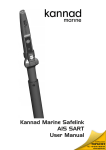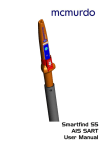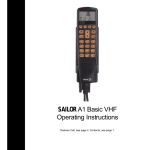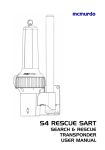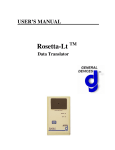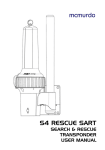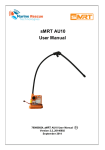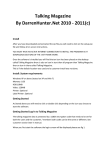Download Self-test of the AIS SART
Transcript
Safety notices WARNING: An AIS SART is an emergency radio beacon. Operate only in situations of imminent danger to life. CAUTION: False alerts endanger lives and cause disruption to Search and Rescue services, deliberate misuse of the AIS SART could result in penalty. CAUTION: If the anti-tamper tab is broken, the SART is not compliant with SOLAS regulations and must be repaired or replaced. CAUTION: Do not dismantle the AIS SART, it contains no user-serviceable parts. CAUTION: Contains lithium batteries. Do not incinerate, puncture, deform, short-circuit or recharge. CAUTION: Dispose of a used AIS SART in accordance with local waste disposal regulations. Refer to End of Life Statement. CAUTION: Avoid using chemical solvents to clean the AIS SART as some solvents can damage the case material. CAUTION: An AIS SART is a radio transmitter. Some administrations may require that the user holds a valid radio licence to cover its ownership and use. Radio Frequency Exposure Warning WARNING: The AIS SART emits low levels of radio frequency radiation; avoid handling the upper section antenna zone when activated. Ownership details Vessel Name: Owner details: Unique ID; 9 7 0 Disclaimer Any responsibility or liability for loss or damage in connection with the use of this product and the accompanying documentation is disclaimed by Thrane & Thrane. The information in this manual is provided for information purposes only, is subject to change without notice and may contain errors or inaccuracies. Manuals issued by Thrane & Thrane are periodically revised and updated. Anyone relying on this information should acquire the most current version e.g. from thrane.com or from the distributor. Thrane & Thrane is not responsible for the content or accuracy of any translations or reproductions, in whole or in part, of this manual from any other source. Page 1 IN EMERGENCY The AIS SART is a locating radio beacon for use only in emergency situations. False alerts endanger lives; help prevent them by understanding how to look after and correctly operate the AIS SART. Introduction Thank you for purchasing the AIS SART ‘ search and rescue locating device’ . The AIS SART is designed to assist in survivor craft location during search and rescue operations. The AIS SART is primarily intended for fitment by SOLAS vessels under carriage requirement rules. SOLAS fitting rules differ depending on type and size of vessel and survival craft. In general, at least one search and rescue locating device is carried on each side of every passenger and cargo ship over 500 gross tons. Smaller SOLAS classified vessels are required to carry at least one search and rescue locating device. The AIS-SART is a portable device and should be stowed on board in a location where it can be easily and rapidly placed in any survival craft. Product registration Each AIS SART carries a unique serial number printed on the label on the orange body. It is recommended that a record of the AIS SART unique identifier number should be kept by the vessels management organisation. Page 2 Overview 1 1 2 Red LED The key components of the AIS SART: 3 1. Hanger eye Inside life raft attachment point, use the lanyard cord to tether the AIS SART to the survival craft. 4 2. Antenna Contained within top section. 5 6 An AIS SART is intended to be a one-shot device, once activated it willAntenna transmit emergency alerts for at least 96 hours. 3. Test button Self-test verifies the readiness of the AIS SART. 4. Red LED Indicates the operating status. 5. Activation Button Break off the anti-tamper tab to gain access to the ON button 6. GPS Zone Do not obstruct 8 7. Metal strap Flexible retaining link to mounting pole 7 8. Mounting Pole: Telescopic pole Sections Fit AIS SART body into mounting pole socket, remove rubber cover and extend pole sections as required. Page 3 AIS SART pictured left is ready for deployment with the mounting pole fully extended. The activated AIS SART should be positioned upright and with a clear view of the sky. Do not obstruct the GPS zone marked on the side. The AIS SART should be arranged to be manually erected when the liferaft is deployed. The antenna datum marked on the pole section should be positioned more than one metre above sea level when the AIS SART is deployed. TEST button Self test verifies the readiness of the AIS SART Second function Press and hold the TEST button to turn the unit OFF Red LED ON button Page 4 Indicates the operating status. To activate the AIS SART Press the ON button until the Red LED starts to flash. Deployment procedure 1. 2. 3. 4. 5. 6. Lift stowage bag off its wall mounting bracket Carry to liferaft using the strap provided Open bag and remove the SART Fold the pole down and insert the SART into the top of the pole Remove the rubber end cover from the pole and release pole sections Twist the sections to lock them in fully extended position 1 2 3 4 Page 5 5 6 Page 6 Activation procedure 1. Break-off the protective anti-tamper tab to gain access to the ‘ ON’ button beneath. 2. Press the ‘ON’button 3. The Red LED indicator light will start to flash every few seconds Page 7 Red LED indication (AIS SART ON) 1 flash every 3.5 seconds The first AIS transmission is made after 50 seconds. This short delay allows time to switch off the AIS SART, if activated in error. 4. GPS position fix indication GPS good A good GPS position fix is indicated by the Red LED signalling a long flash every minute. De-activation of the AIS SART Should the AIS SART be activated by mistake or if the emergency ends; then the AIS SART can be switched OFF by depressing the TEST button for 2 seconds, the Red LED will go out. Important After activation the AIS SART requires replacement of the anti-tamper tab and will need a new battery. Refer to service section for further details. Page 8 Deployment guidelines The AIS SART will work best when the top section has an unobstructed view of the sky. Do your best to maximise the sky view. The antenna datum marked on the pole section should be positioned more than one metre above sea level when the AIS SART is deployed. Tie the securing lanyard to the survival craft to avoid loss of the AIS SART. Activate and then deploy the AIS SART. Mounting outside a canopy life raft. Remove the rubber cover from the bottom of the mounting pole and allow the pole sections to drop. Lock each section together by twisting each section. Release the lanyard spool and tether the free end of the lanyard to a securer fixing point within the survival craft. Please the diagram below. Insert the AIS SART through the SART deployment port in the survival craft canopy. Position the bottom of the support pole within the locating pocket. Secure the pole to the canopy support. Depending on the type of survival craft, the mounting pole can also be located on the outboard side of the survival craft at the doorway entrance on the boarding ramp side. The AIS SART is mounted in the same way except the pole is secured to the buoyancy support. Mounting inside a canopy life raft. The SART should be switched ON and suspended at highest point of the survival craft; by its top loop using the lanyard provided. It is not necessary to fully extend the pole sections. Note: Operating the AIS SART inside a closed Survival Craft or under a canopy may reduce its performance. Page 9 Self-test of the AIS SART Self test button Press and hold for 2 seconds to start the self-test routine. RED LED indicates self test in progress. It is recommended to self-test the AIS SART annually; more frequent self-testing can put unnecessary drain on the battery. When self-testing, a specially coded AIS test transmission is sent that will be visible to all AIS users in the locality. As a successful self-test result is dependant on a valid GPS acquisition; testing must be carried out in the open and under an unobstructed sky. Self test procedure Remove the AIS SART from its stowage case and assemble the top section onto the mounting pole. It is not necessary to fully extend the mounting pole. Take the AIS SART outside and hold it aloft under a clear view of the sky; this will then maximise the speed of the GPS position fix. Proceed as follows:1. 2. 3. 4. 5. Push and hold the TEST button down until the red LED lights. The red LED will flash quickly indicating that the self test routine is in progress. The maximum self-test duration is five minutes (typically 1min) A successful self-test will result in the red LED signalling 3 long flashes. Once the self-test has completed the AIS SART will switch off automatically. A self-test failure will result in no pass indication from the red LED. In this unlikely event, it is recommended to further improve the sky view and to repeat the self-test procedure. Self test verification by ships AIS equipment As part of the self test routine the AIS SART will make a series of live test transmissions. These transmissions can be received by AIS equipped vessels in the local vicinity. The test message includes the AIS SART’ s unique 9 digit ID number, position in latitude and Longitude and is normally identified on the receiving AIS equipment as a ”SART TEST”. Important Unnecessary self testing of the AIS SART can reduce the overall run time available in an emergency. Each self test draws a small amount of energy from the battery. If the AIS SART has been activated for a cumulative period in excess of 6 hours (self-test and operation), then the battery must be replaced to ensure that in an emergency it will still operate for a minimum of 96 hours at -20 pC as required by International Regulations. An AIS SART that fails self-test should be immediately removed from service; refer to the maintenance section for further information. Page 10 Refitting into the bulkhead bracket Fit the AIS SART and accessories inside the stowage case and close the cover and lid. Bracket Align stowage bag over bracket hooks and drop into place. Secured the strap handle around the base of the bag. Page 11 Bulkhead bracket installation The AIS SART portable stowage case should be located where it will not hinder day-to-day operations. Chose a protected location away from the extreme effects of the weather and protected from powerful vessel wash down hoses. Where possible, position the AIS SART adjacent to the ship’ s bridge wing exits ready for easy access in an emergency. The AIS-SART portable stowage case fits over the permanently installed bulkhead bracket. Allow a minimum of 250mm clear space above the highest point of the mounting bracket to allow the bag to be stowed and removed from the bracket. 250mm access space above Mounting procedure The bulkhead bracket is designed to mount on a flat surface using three fixing points Fix the mounting bracket in place using the three stainless steel screws (25mm in length) provided. Or use stainless steel bolts with locking nuts or shake proof washers. Check that the rear side of the mounting surface is clear and that the fixing screws will not penetrate equipment fitted on this surface. Offer the bracket into the chosen position and mark through the mounting slots using the bracket as a template. Drop the AIS SART stowage bag over the bracket; push the bag firmly into place. Stowage options The Stowage bag provides additional protection for the AIS SART if you intend to keep it in a carry off ‘ safety ditch bag‘ or when transporting it from place to place. Page 12 Dealing with a transmitting AIS SART In the unlikely event that the AIS SART develops a fault and will not turn off you can prevent its transmissions by removing the lower battery section. To do this, undo the three fixing screws located around the main body. Release the battery pack and unplug the flying battery connector(s). Note; with the battery pack removed the AIS SART (and battery pack) are not waterproof and must not be allowed to get wet. Refer to product safety warnings. Routine maintenance Self test the AIS SART annually, check that the battery is in date and examine the outer case and bracket for any signs of damage. If required, clean the outer case with fresh water, wipe dry and examine the AIS SART and bracket for any damage. CAUTION: Never use chemical solvents to clean the AIS SART or stowage bag. After activation The anti tamper switch cover should be replaced by a service agent. CAUTION: The battery may be run down and need replacement (see below). Inadvertent operation The anti-tamper switch cover should be replaced by a service agent and the remaining battery life checked (see below). Battery replacement The battery should be changed after five years in service. The exact battery expiry date is marked on the label of the battery pack. The battery must be replaced when: i i The expiry date has been reached or The AIS SART has been activated for more than 6 hours of use. Servicing It is recommended that battery change should be performed by an authorised Sailor service agent in order that a complete assessment and integrity check can be performed. Keep the original packing material for reuse whenever the AIS SART is sent for battery replacement or service. Page 13 Spare parts Item 92-057-003A Battery kit 92-051A Anti tamper tab kit 92-052-003A Storage case 92-053A Wall mounting kit 92-054A Lanyard 92-055A Pole kit 92-059-003A User Manual Contents Battery pack and sealing kit Switch cover and sealing kit Empty case with packing insert. Bracket and fixings Coiled 10m lanyard Pole with fitting parts This document Transportation Passenger Aircraft; This product contains small lithium metal batteries. The AIS SART can normally be taken on board a passenger aircraft as a personal item in carry-on hand baggage. We recommend declaring the AIS SART to airline staff at check in, in the same way you would for a laptop PC or video camera. As air cargo; This product contains small lithium metal batteries. Due to the overall low level of lithium content the AIS SART maybe classed as ‘ not restricted’for air cargo when handled according to requirement PI 970 of the IATA Dangerous Goods Regulations. Always check with the carrier concerned for any additional shipment restrictions that may apply. Page 14 Specifications Type Operation IMO AIS SART Manual activation switch Power output AIS message type Modulation Antenna Non float free Protected by anti tamper cover. Checks transmitter, battery, GPS and indicators. AIS1, 161.975 MHz AIS2, 162.025 MHz 1 W EIRP 1, 14 GMSK Integrated vertical element Battery Type Operating life Storage Service Lithium metal 96 hours minimum 6 years Replaceable GNSS GPS 20 channel Environment Operating temperature Storage temperature Waterproof Buoyancy Exterior Finish Compass safe distance -20 pC to +55 pC -30 pC to +70 pC Immersion to 10m Floats Highly visible yellow 0.2m Physical Weight (main unit ) Weight, (including pole) 160 grams 450 grams Self test AIS Transmitter Operating frequency Size (main unit pole folded) H330 x W85 (mm) Overall length including pole 155 cm fully extended Lanyard 10 m, 50Kg breaking strain Mounting Stowage case (packed) Bulkhead bracket 940g H390 x D80 x W150 (mm) 230g Standards applied AIS SART Radio GNSS / GPS IMO IEC 61097 -14, IEC 60945 ITU – R M.1371 IEC 61108-1 MSC.246(83) Page 15 Stowage case AIS-SART before deployment End of Life Statement At the end of the products useful life, it is vital that the battery is removed from the main body of the AIS SART to prevent false alerts. False alerts cause expensive disruption to Search and Rescue services and may endanger lives as a consequence. Safe disposal Contains traces of lithium, may contain traces of lead and brominated flame retardants (BFRs), both in the housing material and circuit boards. DO NOT INCINERATE It is strongly recommended that this product is disposed of in a sensible and considerate manner. For example, do not simply discard the product in the domestic waste. Instead take it to a civil recycling facility, or contact your suppler for further advice. Page 16 Document number: 98-133455-A Release date: November 1, 2012 Page 17




















